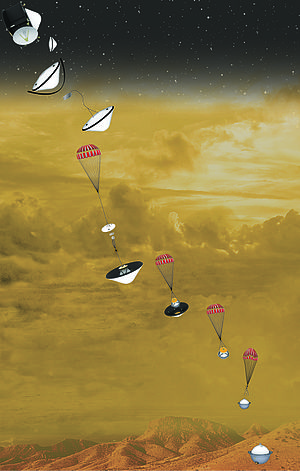
Back DAVINCI Catalan DAVINCI (Raumsonde) German DAVINCI Spanish داوینچی (ماموریت فضایی) Persian DAVINCI+ French DAVINCI+ ID DAVINCI Italian 다빈치+ Korean DAVINCI Polish DAVINCI Portuguese
 Artist's concept of DAVINCI's descent stages | |||||||||||||||||
| Names | DAVINCI (2015–2019) DAVINCI+ (2019–2021) DAVINCI (2021–) | ||||||||||||||||
|---|---|---|---|---|---|---|---|---|---|---|---|---|---|---|---|---|---|
| Mission type | Venus orbiter / atmospheric probe | ||||||||||||||||
| Operator | NASA / Goddard | ||||||||||||||||
| Website | ssed.gsfc.nasa.gov | ||||||||||||||||
| Mission duration | Descent: ~1 hour[1] Surface operations: ~17 minutes[1] | ||||||||||||||||
| Spacecraft properties | |||||||||||||||||
| Manufacturer | Lockheed Martin Goddard | ||||||||||||||||
| Start of mission | |||||||||||||||||
| Launch date | Planned: 2031–2032[2] | ||||||||||||||||
| Rocket | Atlas V or equivalent | ||||||||||||||||
| End of mission | |||||||||||||||||
| Landing date | 2034[2] | ||||||||||||||||
| Landing site | Alpha Regio[3] | ||||||||||||||||
| Venus orbiter | |||||||||||||||||
| Spacecraft component | Orbiter | ||||||||||||||||
| Orbital insertion | 2034–2035[3] | ||||||||||||||||
| Venus atmospheric probe | |||||||||||||||||
| Spacecraft component | Probe | ||||||||||||||||
| Atmospheric entry | 2034[3] | ||||||||||||||||
| |||||||||||||||||
DAVINCI (Deep Atmosphere Venus Investigation of Noble gases, Chemistry, and Imaging) is a planned mission for an orbiter and atmospheric probe to the planet Venus. Together with the separate VERITAS mission, which will also study Venus, it was selected by NASA on 2 June 2021 to be part of their Discovery Program.[4][5][6] Its acronym is inspired by Leonardo da Vinci in honor of his scientific innovations, aerial sketches and constructions.
DAVINCI will send both an orbiter and a descent probe to Venus.[7] The orbiter will image Venus in multiple wavelengths from above, while the descent probe will study the chemical composition of Venus's atmosphere and take photographs during descent.[8][9] The DAVINCI probe will travel through the Venusian atmosphere, sampling the atmosphere, and returning measurements down to the surface. These measurements are important to understanding the origin of the atmosphere, how it has evolved, and how and why it is different from the atmosphere of Earth and Mars. The measurements taken by DAVINCI will investigate the possible history of water on Venus and the chemical processes at work in the unexplored lower atmosphere. Before it reaches the surface, the DAVINCI probe will capture high-resolution images of the planet's ridged terrain ("tesserae"), returning the first images of the planet's surface since the Soviet Venera 14 lander in 1982. It will also collect data for studying the planet's origin, and its tectonic and weathering history.
- ^ a b Cite error: The named reference
nasa3was invoked but never defined (see the help page). - ^ a b Cite error: The named reference
nasa1was invoked but never defined (see the help page). - ^ a b c Cite error: The named reference
nasa-20210602awas invoked but never defined (see the help page). - ^ Cite error: The named reference
nasa-20210602bwas invoked but never defined (see the help page). - ^ Cite error: The named reference
NYT-20210602was invoked but never defined (see the help page). - ^ Cite error: The named reference
theverge1was invoked but never defined (see the help page). - ^ Cite error: The named reference
Garvin_2020was invoked but never defined (see the help page). - ^ Cite error: The named reference
nasa-20150930was invoked but never defined (see the help page). - ^ Cite error: The named reference
tps1was invoked but never defined (see the help page).
© MMXXIII Rich X Search. We shall prevail. All rights reserved. Rich X Search